Building on our work in 2020, we are delighted to share our impact for the year 2021
It’s been two years since we launched Samasthiti – a platform to change people’s lives through robust financial planning. The first year was challenging, to say the least. Soon after we launched Samasthiti, the country went into lockdown. However, the pandemic also underscored the importance of financial planning. Families that had been postponing this exercise were now beginning to understand the importance of planning ahead.
At the end of our first year of operation, we had shared a post on the impact of Samasthiti’s services on our clients’ financial lives. While we knew that our work was making a positive impact, the actual numbers took us by surprise.
So we’ve decided to make this an annual tradition and hence we are delighted to present to you our impact story for the year 2021. We hope you enjoy reading the same.
Samasthiti’s model has two key features that makes us really standout:
We are advisers. We do not take a penny of commission from financial product companies. We knew that taking commissions would come in the way of providing unbiased advise. Hence, Samasthiti’s entire revenue comes directly from our clients allowing us to provide honest advise.
The second feature is our transparent fee structure. We charge a fixed fee for the services we provide regardless of the portfolio size of our clients. A fixed fee, which is decided based on the work involved, prevents us from discriminating between low-income and high-income clients. As a fixed fee-only advisor, we do not size up clients depending on their wealth. This enables us to welcome any client irrespective of which income strata they come from.
In the past year, it has become apparent that our strength lies in our commitment to a zero-commission and fixed fee model. We are happy to share with you the impact that Samasthiti has been able to make in the financial lives of our clients. We have been able to,
Reduce the annual cost of clients’ mutual fund portfolios from an average of 1.7 percent to 0.7 percent
Streamline clients’ mutual fund portfolios by reducing exposure from an average of 11 mutual fund schemes to an average of 6 mutual fund schemes
Restrict clients’ exposure to cocktail investment products (that offer a multitude of benefits none of which is substantial) and get them to invest in simple but powerful investment products. For instance, more than a third of our clients who did not have PPF accounts earlier, have now opened such an account and started contributing to it.
The Easiest Way to Earn Higher Returns is to Cut Costs
An average investor goes to great lengths to try and increase the return on their portfolios. Most of the time this desperate search for higher return increases their vulnerability to being mis-sold a risky financial product. We seem to be willing to jump many hula hoops in our quest for higher returns and we forget that one of the most powerful methods of increasing our portfolio’s return is to cut costs.
Every financial product has a cost. This cost can be broken into two components – a part of the cost flows to the manufacturer of the financial product, and the other part to the intermediary who distributes the product in the market. All investors should look closely at these costs with a hawk eye.
At Samasthiti, we have been extremely finicky about costs. The reason is obvious – every penny saved in costs immediately flows into earning a higher return from your portfolio. Several of our clients are young who are investing for their retirement which is at least 20 years away and an annual saving of 1 percentage point in cost translates to an additional retirement corpus of more than 20 percent.
The average cost of our clients’ mutual fund portfolio was 1.7 percent per annum earlier, and this average has come down to 0.7 percent per annum post their financial planning exercise. This corresponds to a savings of 1 percent annually. This savings was achieved by not only enabling our clients to invest directly in financial products, bypassing all intermediaries, but also by avoiding high-cost financial products.
Reduction in investment cost
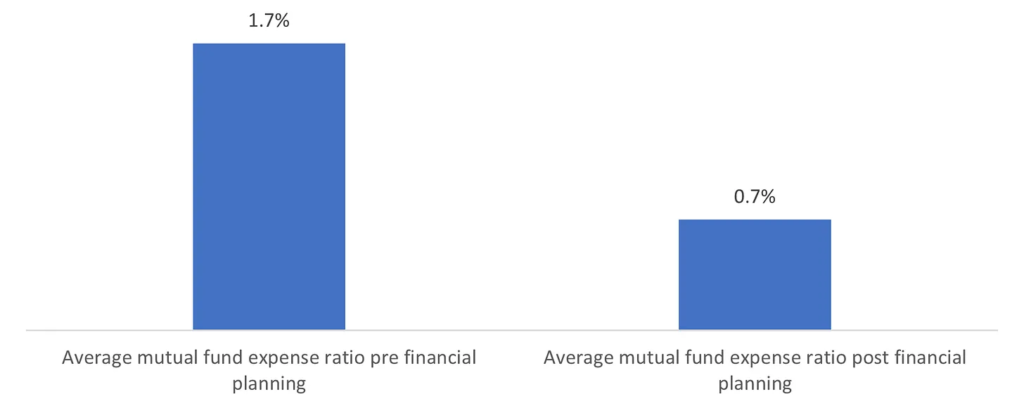
There’s more to it. A saving of 1 percent annually is only the tip of the iceberg. This is because an investment strategy that emphasises on being cost conscious will automatically avoid cocktail investment products and prioritize low cost, simple, efficient, and robust financial products. Thus, being cost conscious is an investor’s best strategy to avoid ending up with an inferior investment product.
We cannot emphasize this enough – costs matter, a lot.
We do not believe in the Spray and Pray approach
We always had an inkling that investors over-diversify when investing in mutual funds. This is because of the way mutual funds are sold in India. Every new mutual fund offer is marketed heavily on the back of fat upfront commissions. Even among the existing mutual fund schemes, the commission paid keeps changing depending on the marketing strategy of the mutual fund company and different schemes are promoted at different points of time. These perverse incentives encourage the average investor to invest in whatever is the flavour of the season – and the flavour keeps changing.
Thus, rather than identifying a few good mutual fund schemes and accumulating savings in them consistently, more often than not, investors are encouraged to spray their savings over a host of mutual fund schemes and pray.
During the course of the last year, we witnessed portfolios – some with more than 30 different mutual fund schemes! The exposure to a large number of mutual fund schemes is also a reflection of an abject lack of clarity in designing one’s portfolio.
Streamlining Portfolios
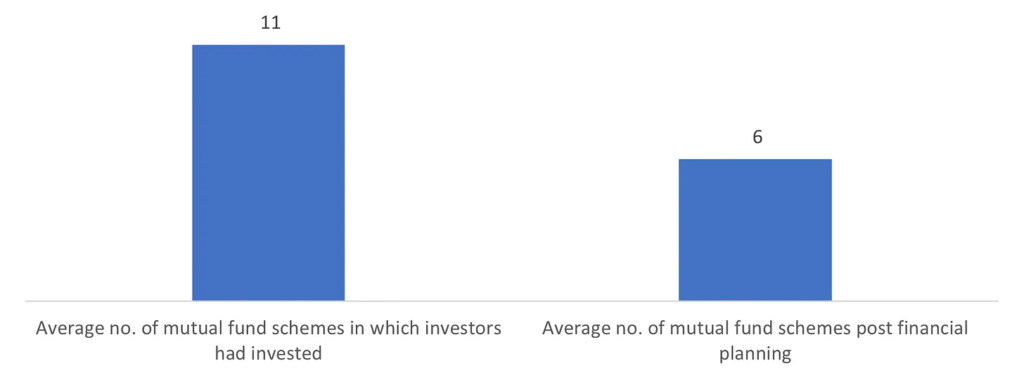
In our financial planning process, we pay special attention to cleaning messy mutual fund portfolios. Through careful analysis, we have been able to streamline our clients’ mutual fund holding from an average of 11 different schemes to an average of 6 different schemes.
Simple is Powerful
Cocktail financial products are those that combine multiple objectives. The most common cocktail products are those that combine investment and insurance, like Unit-Linked-Insurance-Plans (ULIPs) or traditional LIC policies. Such products are a marketers’ delight as the product complexity allows for innovative but obfuscating packaging. Such products, though, struggle to achieve any of their objectives.
What is worse, the cocktail nature of their design provides a cover for charging high fees. These high fees enable the manufacturer of such products to pay attractive commissions on their sale. Little surprise then that an average retail investor’s portfolio will have a decent sprinkling of cocktail financial products. Among our client base, close to 50 percent of them either had an investment in a ULIP or a LIC policy.
Cutting out complexity
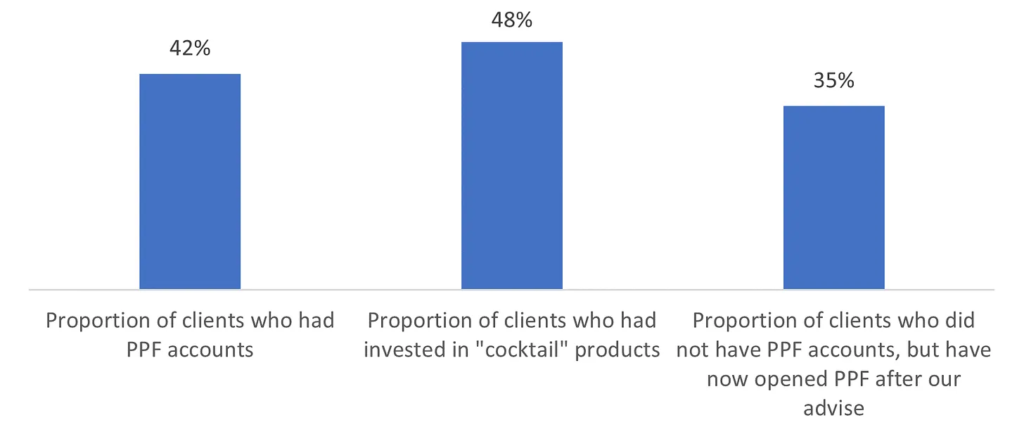
Compare this to the fact that only about 40 percent of our clients had a Public Provident Fund (PPF) account when they approached us. This is despite the fact that PPF is one of the best investments you can make. Unfortunately, the simplicity of PPF is perceived as being boring, rather than being interpreted as its strength. Nobody wants to talk about PPF as there is no commission to be made on getting people to open PPF accounts. At Samasthiti, we strongly advise our clients, where applicable, to open a PPF account and contribute to it regularly.
More than a third of our clients who did not have PPF accounts earlier have now opened such an account and started contributing to it.
So that pretty much sums up the year 2021 for us. We have succeeded in cutting costs, thus enabling our clients to earn higher returns. We have steered away from complex financial products and streamlined over-diversified portfolios. We have enabled our clients to invest in simple yet powerful products that have the potential to meet their financial needs and we have spent a lot of time counselling our clients to stay true to their financial plan.
There’s just one more thing we have managed to do but we cannot put a number next to it because its priceless – the beautiful relationships we have built with our clients and their families over the last two years. We are truly thankful for your love and support and we count our blessings everyday!

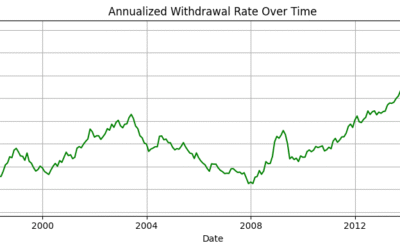
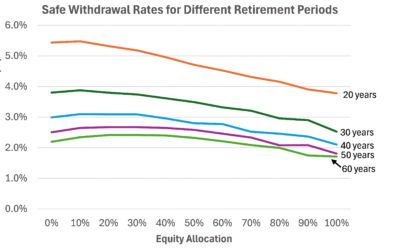
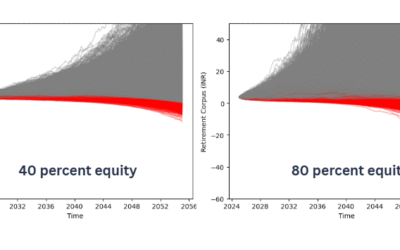



0 Comments